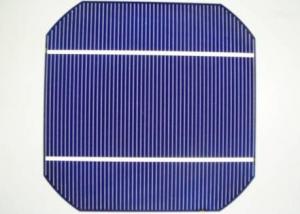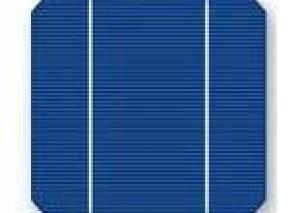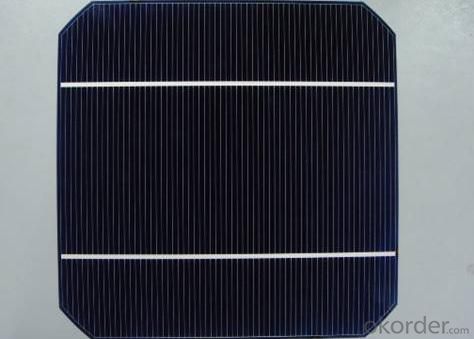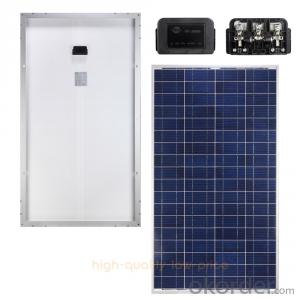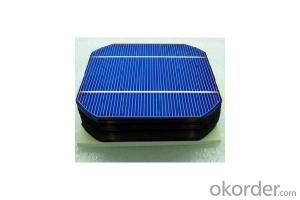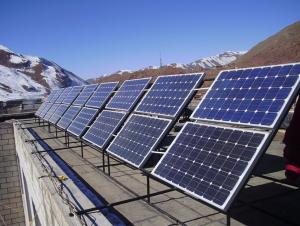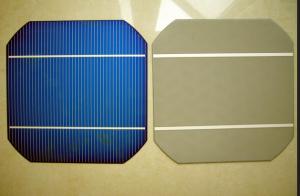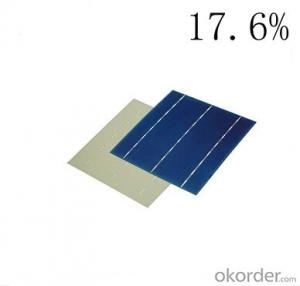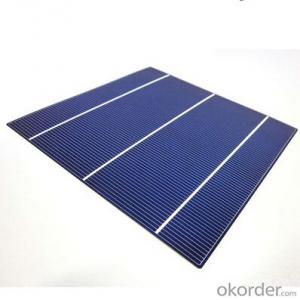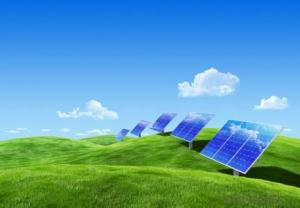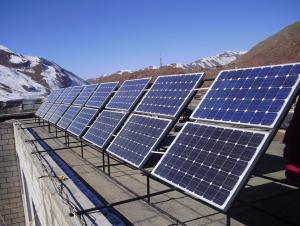Well Design High Efficiency Monocrystalline Silicon Solar Cells for Energy Transfer
- Loading Port:
- Tianjin
- Payment Terms:
- TT or LC
- Min Order Qty:
- 1200 watt
- Supply Capability:
- 700 watt/month
OKorder Service Pledge
OKorder Financial Service
You Might Also Like
Mechanical data and design of High Efficiency Monocrystalline Silicon Solar Cells
Format 125mm × 125mm ± 0.5 mm
Thickness- 210 μm ± 40 μm
Front (-) 1.6mm bus bars (silver),blue anti-reflection coating (silicon nitride)
Back (+) 2.5mm wide soldering pads (silver) back surface field (aluminium)
Temperature Coefficient of Cells
Voc. Temp .coef.%/K -0.35%/K
Isc . Temp .coef.%/K +0.024%/K
Pm. Temp. coef.%/K -0.47%/K
Electrical Characteristic
Efficiency (%) Pmpp (W) Umpp (V) Impp (A) Uoc (V) Isc (A) FF (%)
18.35 2.841 0.532 5.342 0.631 5.67 79.41%
18.2 2.817 0.53 5.319 0.631 5.64 79.16%
18.05 2.794 0.527 5.301 0.63 5.63 78.77%
17.9 2.771 0.527 5.259 0.629 5.62 78.39%
17.75 2.748 0.526 5.224 0.629 5.61 77.88%
17.6 2.725 0.524 5.201 0.629 5.59 77.50%
17.45 2.702 0.52 5.196 0.629 5.586 76.90%
17.3 2.678 0.516 5.183 0.626 5.577 76.71%
17.15 2.655 0.513 5.175 0.623 5.565 76.58%
17 2.632 0.51 5.161 0.622 5.559 76.12%
16.75 2.593 0.508 5.103 0.615 5.477 76.98%
16.5 2.555 0.506 5.047 0.608 5.396 77.88%
Brief introduction of Photovoltaic Cells Solar Panels
Photovoltaic Cells Solar Panels convert the solar radiation through the photoelectric effect or photochemical effect directly or indirectly into electrical energy by absorbing sunlight; the main material for most solar panels is silicon, but the production cost is so great that it cannot be a large number of widely and commonly used. Compared with ordinary batteries and rechargeable batteries, solar cells belong to more energy saving green products.
Advantages of Photovoltaic Cells Solar Panels
1) Solar energy resources are inexhaustible; solar energy shine on the planet currently consumes is 6,000 times larger than humanity to. Spread on Earth and the solar widespread, there are only local illumination can use solar photovoltaic panels, unrestricted area, elevation and other factors.
2), Solar energy resources are available everywhere, the nearest power supply. Without long-distance walks, preventing long-distance power transmission lines formed off the loss, but also has a throttling transmission costs. This is also the use of solar photovoltaic panels supplied premise transmission inconvenient western planning.
3), Energy conversion process of Photovoltaic Cells Solar Panels generating electricity is brief, which is a direct transition from photons to electrons. There is no central process (thermal energy into mechanical energy, mechanical energy is converted to electromagnetic energy, etc.) and mechanical activity, there is no mechanical wear. Based on thermodynamic analysis, Photovoltaic Cells Solar Panels generation with high theoretical efficiency, up to 80%, technology has great potential to develop.
4), Photovoltaic Cells Solar Panels do not use the fuel itself, does not emit any greenhouse gases and other substances, including gas, polluting air and noise, the impact will not suffer an energy crisis or the formation of the fuel market, is the real green environmental protection, new renewable energy sources.
5), Photovoltaic Cells Solar Panels generate electricity without cooling water process, the device may be in the desolate desert without water. PV can also be conveniently associated with the construction material, the composition of the construction of photovoltaic power generation system integration, covering not demand alone can choke precious resource site.
6), Photovoltaic Cells Solar Panels generate electricity without mechanical transmission components, operation, and maintenance simple, reliable operation of the same. A PV system only has a solar cell module can generate electricity, coupled with automatic control technology widely used; it can be done simply on unattended, low maintenance costs.
7), Photovoltaic Cells Solar Panels generate electricity tasking reliable, the service life (over 30 years). Crystalline silicon solar battery life is up to 20 to 35 years. In the photovoltaic power generation system, the only rational design, modeling appropriate battery life can last up to 10 to 15 years.
8), Photovoltaic Cells Solar Panels have simple structure, small size, light weight, easy to transport and installations. PV systems establish a short cycle, electricity load capacity vary, convenient and sensitive, easily combined expansion.
- Q: What are the advantages of using solar cells?
- There are several advantages to using solar cells. Firstly, solar cells are a clean and renewable source of energy, which means they do not produce harmful emissions or contribute to climate change. Secondly, solar cells can be installed in remote areas without access to electricity grids, providing power to communities that would otherwise be without it. Additionally, solar cells require minimal maintenance and have a long lifespan, making them a cost-effective solution in the long run. Finally, using solar cells reduces dependence on fossil fuels, helping to conserve natural resources and promote a more sustainable future.
- Q: How do solar cells generate electricity at night?
- Solar cells do not generate electricity at night as they rely on sunlight to convert photons into electrical energy.
- Q: Can solar cells be used in electric fences?
- Yes, solar cells can be used in electric fences. They can be used to power the fence's energizer, which delivers an electric shock to deter animals or intruders. Solar cells are efficient in converting sunlight into electricity, making them a sustainable and cost-effective solution for powering electric fences in remote locations without access to the grid.
- Q: Can solar cells be used to power medical devices?
- Yes, solar cells can be used to power medical devices. Solar cells, also known as photovoltaic cells, convert sunlight into electricity. This renewable energy source can be harnessed to power various medical devices such as portable glucose monitors, prosthetics, hearing aids, and even small medical implants. Using solar cells to power medical devices offers a sustainable and convenient solution, especially in remote areas or during emergencies where access to electricity may be limited.
- Q: How do solar cells perform in areas with high levels of industrial emissions?
- Solar cells can perform less efficiently in areas with high levels of industrial emissions due to the presence of air pollutants. These emissions can create a layer of grime on the surface of solar panels, reducing their ability to absorb sunlight. Additionally, air pollution can scatter and block sunlight, further reducing the overall performance of solar cells in such areas. Regular cleaning and maintenance of solar panels may help mitigate the impact of industrial emissions on their performance.
- Q: How do solar cells perform in areas with high levels of air pollution?
- Solar cells can be affected by high levels of air pollution as it can reduce their efficiency. The presence of pollutants in the air can decrease the amount of sunlight reaching the solar cells, leading to a decrease in their overall performance. Additionally, pollutants such as dust, soot, and smog can accumulate on the surface of the solar panels, further reducing their efficiency by blocking and scattering sunlight. Therefore, in areas with high air pollution, solar cells may not be able to perform at their optimal levels and may require more frequent cleaning and maintenance to ensure their effectiveness.
- Q: What is the average lifespan of a solar cell in space?
- The average lifespan of a solar cell in space can vary depending on various factors such as the quality of the materials used, the level of radiation exposure, and the overall design of the solar cell. However, on average, solar cells in space can last anywhere between 10 to 25 years.
- Q: How do solar cells impact job creation?
- Solar cells impact job creation in several ways. Firstly, the installation and maintenance of solar panels require skilled workers, creating job opportunities in the renewable energy sector. Additionally, the manufacturing of solar cells creates employment in the production and supply chain. As the demand for solar energy continues to grow, more jobs will be created in research, development, and sales. Overall, the adoption of solar cells stimulates job growth and contributes to the transition towards a green economy.
- Q: Can solar cells be installed on curved surfaces?
- Yes, solar cells can be installed on curved surfaces. Flexible solar panels and technologies like thin-film solar cells allow for installation on various curved surfaces such as vehicles, buildings, and even clothing.
- Q: What is the impact of snow accumulation on solar cell performance?
- Snow accumulation can significantly reduce the performance of solar cells. The presence of snow on the surface of solar panels prevents sunlight from reaching the cells, thereby reducing their ability to generate electricity. Additionally, the weight of the snow can cause structural damage to the panels and potentially lead to their failure. Therefore, snow accumulation must be cleared promptly to ensure optimal solar cell performance.
1. Manufacturer Overview
| Location | Zhejiang, China |
| Year Established | 2008 |
| Annual Output Value | Above US$ 320 Million |
| Main Markets | Australia; Asia; South East Asia; South America; North America; Europe; Africa |
| Company Certifications | ISO 9001:2008; CE; TUV; UL |
2. Manufacturer Certificates
| a) Certification Name | |
| Range | |
| Reference | |
| Validity Period |
3. Manufacturer Capability
| a) Trade Capacity | |
| Nearest Port | Ningbo, China |
| Export Percentage | 45% - 50% |
| No.of Employees in Trade Department | 200-300 People |
| Language Spoken: | English; Chinese |
| b) Factory Information | |
| Factory Size: | Above 10,000 Square meter |
| No. of Production Lines | 8 |
| Contract Manufacturing | OEM Service Offered; Design Service Offered |
| Product Price Range | Average |
Send your message to us
Well Design High Efficiency Monocrystalline Silicon Solar Cells for Energy Transfer
- Loading Port:
- Tianjin
- Payment Terms:
- TT or LC
- Min Order Qty:
- 1200 watt
- Supply Capability:
- 700 watt/month
OKorder Service Pledge
OKorder Financial Service
Similar products
Hot products
Hot Searches
Related keywords


